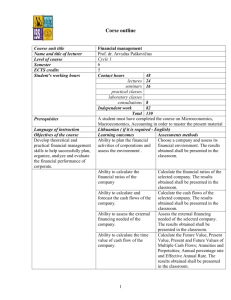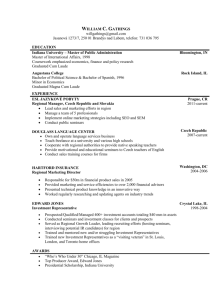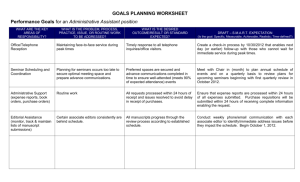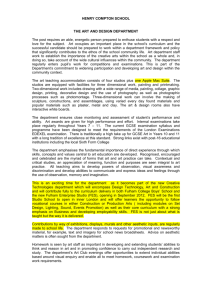Internal diseases
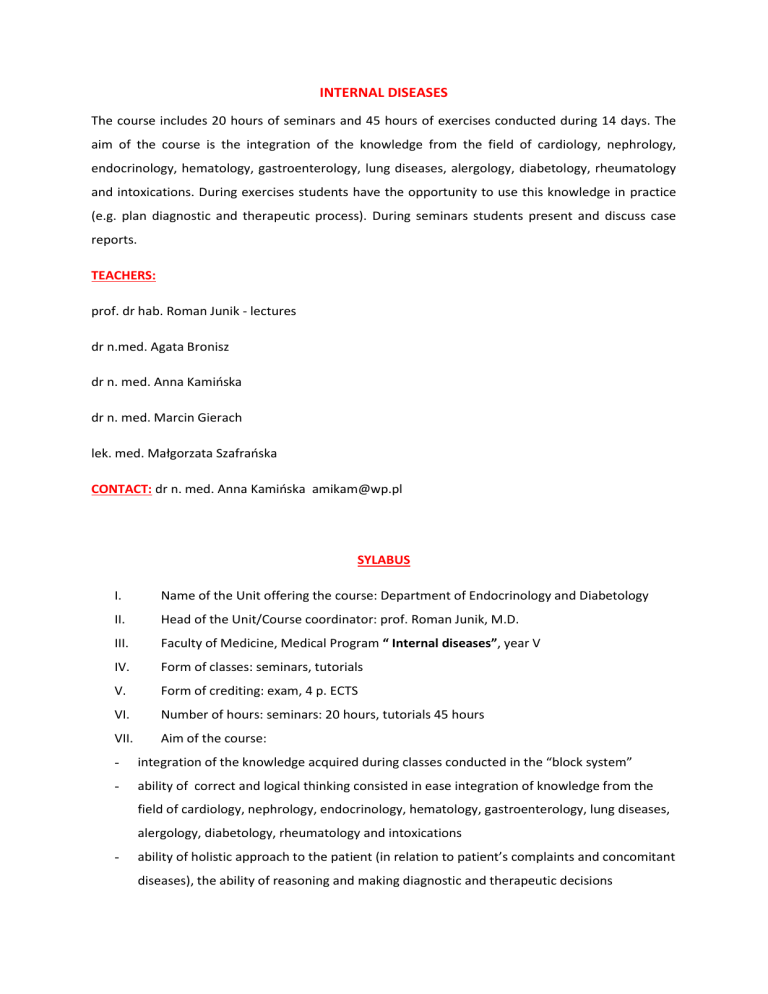
INTERNAL DISEASES
The course includes 20 hours of seminars and 45 hours of exercises conducted during 14 days. The aim of the course is the integration of the knowledge from the field of cardiology, nephrology, endocrinology, hematology, gastroenterology, lung diseases, alergology, diabetology, rheumatology and intoxications. During exercises students have the opportunity to use this knowledge in practice
(e.g. plan diagnostic and therapeutic process). During seminars students present and discuss case reports.
TEACHERS: prof. dr hab. Roman Junik - lectures dr n.med. Agata Bronisz dr n. med. Anna Kamińska dr n. med. Marcin Gierach lek. med. Małgorzata Szafrańska
CONTACT: dr n. med. Anna Kamińska amikam@wp.pl
SYLABUS
I.
II.
Name of the Unit offering the course: Department of Endocrinology and Diabetology
Head of the Unit/Course coordinator: prof. Roman Junik, M.D.
III.
Faculty of Medicine, Medical Program “ Internal diseases”, year V
IV.
Form of classes: seminars, tutorials
V.
Form of crediting: exam, 4 p. ECTS
VI.
Number of hours: seminars: 20 hours, tutorials 45 hours
VII.
Aim of the course:
integration of the knowledge acquired during classes conducted in the “block system”
ability of correct and logical thinking consisted in ease integration of knowledge from the field of cardiology, nephrology, endocrinology, hematology, gastroenterology, lung diseases, alergology, diabetology, rheumatology and intoxications
ability of holistic approach to the patient (in relation to patient’s complaints and concomitant diseases), the ability of reasoning and making diagnostic and therapeutic decisions
VIII.
Topics of classes
Seminars
Presentation of case report (results of medical history and physical examination, initial diagnosis, differential diagnosis, the aim of additional examinations, conclusions from the results of additional examinations, final diagnosis (main disease and concomitant diseases with their impact on main disease), treatment (and advances in treatment), prognosis.
Presentation of patient’s diseases and relations between them
Explanation of patient’s symptoms with use of the knowledge from pathophysiology and pathomorphology
Emergency in internal diseases
Chronic complications of diabetes. Multiple neoplasia syndromes. Principles of hematology
Exercises
Assessment of patient’s general condition
Medical history and physical examination in internal diseases
Making initial diagnosis
Planning and carrying out differential diagnosis, with ability of explanation the purpose of planned examinations
Making final diagnosis
Planning treatment and its modifications in relation to disease progression, concomitant diseases and advances in therapy
Ability to prognose disease progression, its consequences, knowledge about the prevention of disease consequences and side effects after treatment
Medical documentation: case record, temperature card and other documents
Presentation of clinical problem during doctor’s round and consultations
First aid in emergency
Treatment in emergency
IX.
Self-study topics
Students have the possibility of self - study at home and in library with use of recommended literature. Individual self-study in free time during the exercises in the
Unit are also possible (after approval by academic teacher).
X.
Booklist
XI.
1.
Harrison's Principles of internal medicine, Sixteenth Edition (basic)
Required practical skills
Assessment record
Name, surname:
Year of the study: group number:
Academic year:
Practical skills
Medical history and physical examination.
Interpretation of laboratory, imaging and endoscopic examinations
Diagnosis (including differential diagnosis)
Therapy (including contraindications and side-effects)
Date Confirmation
(signature)
Comments
Confirmation of completing
Obtainment of a credit is confirmed by the entry in a Student Record Book, in a term results card and in the credit protocol
RULES AND REGULATIONS
Course title: Internal diseases
Year: V
I.
Form and conditions of crediting
Examination
II.
Form and conditions of crediting the classes:
Credit without grade
The conditions of crediting the classes:
- active participation in all seminars and classes
- presentation of case report
- the acquirement of practical skills (as shown in assessment record)
- passing the colloquium.
III.
Form of passing the colloquium
The final colloquium is a 20-questioned test and is carried out in the last day of the course. If student fails the colloquium, he/she has the right to re-sit it. The date of re-sit colloquium should be established with the Head of the Unit.
IV.
Form of exam
The course “Internal diseases” is ended with the exam. The exam consist of 3 parts – test, practical and theoretical (oral). The conditions of passing the exam are resolved in separate regulations.
V.
Rules of make-up the classes missed
The participation in seminars ad classes is obligatory. Students who were absent should participate in seminars and classes with another group. If it is not possible due to organizational reasons, alternative form of make –up the classes missed is the participation in emergency service (4 hours for one day of classes missed) or during two first weeks of September (in term approved by the
Head of Unit). The participation in emergency service should be approved by physician on duty
VI. Deadlines to deliver elaboration, reports or different forms required in the Unit
Case report are presented by students during seminars
VII. General and detailed Management of Health and Safety at Work Regulations required during teaching program in the Unit
Students are obliged to comply with general Management of Health and Safety at Work Regulations.
All procedures carried out during classes by students are supervised by assistants.
Students are obliged to wear white, clean coats, change shoes and wash hands. Eating and drinking in the Department of Endocrinology and Diabetology is prohibited.
The regulations of Internal Diseases’ Examination
1.
The examination in Internal Diseases consists of three parts: practical exam, written test and oral theoretical exam.
2. Practical exam is taken after successful completing the internal diseases course either immediately after the block of classes is finished or in the exam session.
It is held in the Department where a student attended classes and is conducted by an academic teacher appointed by the Head of the Department. The exam date can be chosen by students.
3. If a student fails practical exam (taken immediately after the course is successfully completed or in exam session) he/she has to re-sit it in exam retake session.
4. Written test for all fifth year students takes place in summer exam session. The place and the time of the exam are determined by internal diseases coordinator and are approved by the Dean.
5. A student can take the written test regardless of whether the practical test was previously taken.
6. A student can take the oral theoretical exam in summer exam session on the condition that he/she previously passes practical exam and written test. If he/she fails practical exam and/or written test he/she is allowed to retake it in exam retake session. When a student passes both practical exam and written test he/she is allowed to retake oral theoretical exam
7.
Information regarding place and time of written test is available in the Office of Centre for
Medical Education in English and Department responsible for conducting the classes.
8. A Student will be allowed to enter the examination room when he/she shows his/her
Students’Identity Card.
9. Test exam results are announced at the place where exam is held within 2 hours after its completion (the results are presented anonymously with the usage of students’ files numbers.
10. Academic teachers responsible for coordinating the course of examination are assigned by the Heads of the Departments
11. The written test consists of 140 questions: 40 questions in cardiology, 20 questions in gastroenterology, 20 questions in endocrinology and diabetology, 20 questions in allergology,
20 questions in hematology, 20 questions in nephrology and arterial hypertension. Each question is worth one point. 60% of points are required to pass the test
12. The level of difficulty should correspond to I and II /class of Bloom’s taxonomy.
13. Students may report objectives to test questions only during the test.
14. 60% of points are required to pass the test. Grades are given according to the scale presented below:
Marks:
92 – 100 % of correct answers – 5.0
84 – 91,9% of correct answers – 4.5
76 – 83,9% of correct answers – 4.0
68 – 75,9% of correct answers – 3.5
60 – 67,9% of correct answers – 3.0 less than 60% - fail (2.0)
15. Written test questions are prepared on the basis of books which were recommended for classes in the 4 th year (cardiology, allergology, gastroenterology, endocrinology and diabetology, nephrology, hematology) as well as on the basis of material presented during seminars
16. Oral theoretical exam is carried out by the professor that is randomly assigned to the group at the beginning of academic year
17. Re – sit examinations and examinations taken by a student who obtains conditional status are carried out by the same professor who is responsible for the exam taken in exam session.
18. Marks are entered to the USOS system by the professor who carries out oral theoretical exam..
